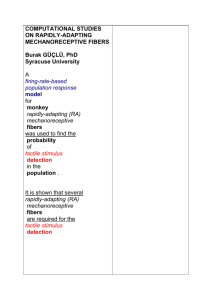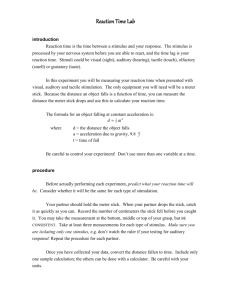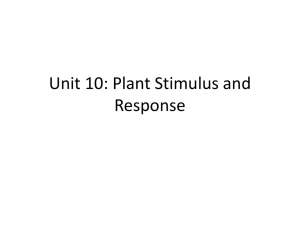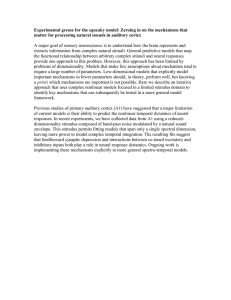Human Tactile Stochastic Resonance Affected by Stimulus
advertisement
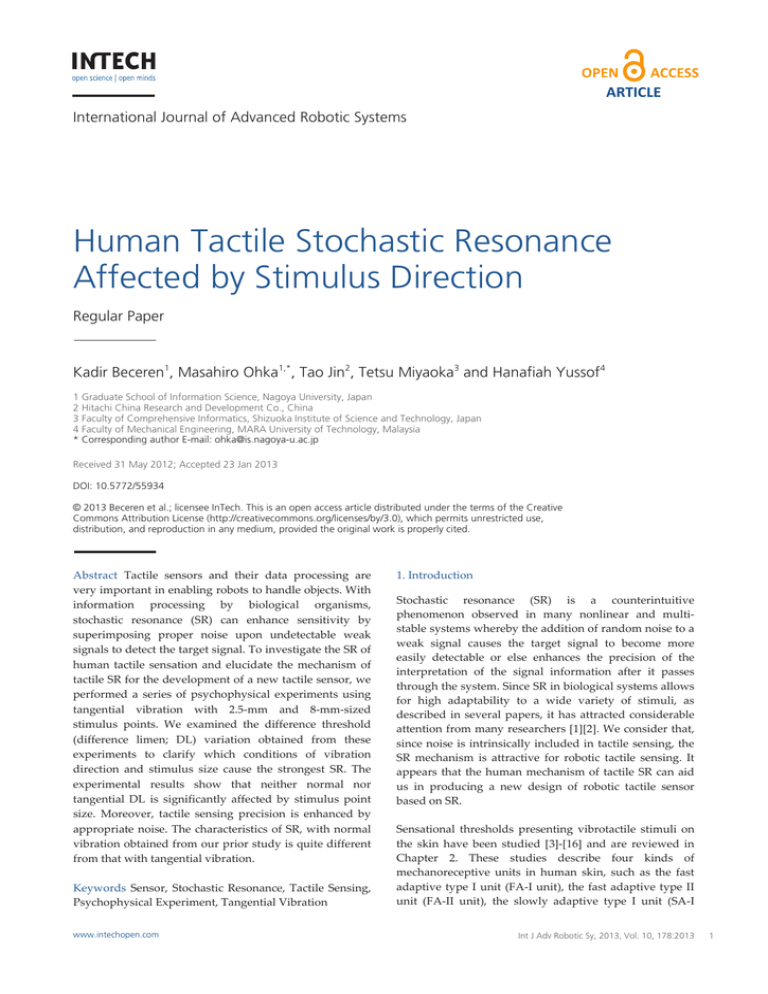
ARTICLE International Journal of Advanced Robotic Systems Human Tactile Stochastic Resonance Affected by Stimulus Direction Regular Paper Kadir Beceren1, Masahiro Ohka1,*, Tao Jin2, Tetsu Miyaoka3 and Hanafiah Yussof4 1 Graduate School of Information Science, Nagoya University, Japan 2 Hitachi China Research and Development Co., China 3 Faculty of Comprehensive Informatics, Shizuoka Institute of Science and Technology, Japan 4 Faculty of Mechanical Engineering, MARA University of Technology, Malaysia * Corresponding author E-mail: ohka@is.nagoya-u.ac.jp Received 31 May 2012; Accepted 23 Jan 2013 DOI: 10.5772/55934 © 2013 Beceren et al.; licensee InTech. This is an open access article distributed under the terms of the Creative Commons Attribution License (http://creativecommons.org/licenses/by/3.0), which permits unrestricted use, distribution, and reproduction in any medium, provided the original work is properly cited. Abstract Tactile sensors and their data processing are very important in enabling robots to handle objects. With information processing by biological organisms, stochastic resonance (SR) can enhance sensitivity by superimposing proper noise upon undetectable weak signals to detect the target signal. To investigate the SR of human tactile sensation and elucidate the mechanism of tactile SR for the development of a new tactile sensor, we performed a series of psychophysical experiments using tangential vibration with 2.5‐mm and 8‐mm‐sized stimulus points. We examined the difference threshold (difference limen; DL) variation obtained from these experiments to clarify which conditions of vibration direction and stimulus size cause the strongest SR. The experimental results show that neither normal nor tangential DL is significantly affected by stimulus point size. Moreover, tactile sensing precision is enhanced by appropriate noise. The characteristics of SR, with normal vibration obtained from our prior study is quite different from that with tangential vibration. Keywords Sensor, Stochastic Resonance, Tactile Sensing, Psychophysical Experiment, Tangential Vibration www.intechopen.com 1. Introduction Stochastic resonance (SR) is a counterintuitive phenomenon observed in many nonlinear and multi‐ stable systems whereby the addition of random noise to a weak signal causes the target signal to become more easily detectable or else enhances the precision of the interpretation of the signal information after it passes through the system. Since SR in biological systems allows for high adaptability to a wide variety of stimuli, as described in several papers, it has attracted considerable attention from many researchers [1][2]. We consider that, since noise is intrinsically included in tactile sensing, the SR mechanism is attractive for robotic tactile sensing. It appears that the human mechanism of tactile SR can aid us in producing a new design of robotic tactile sensor based on SR. Sensational thresholds presenting vibrotactile stimuli on the skin have been studied [3]‐[16] and are reviewed in Chapter 2. These studies describe four kinds of mechanoreceptive units in human skin, such as the fast adaptive type I unit (FA‐I unit), the fast adaptive type II unit (FA‐II unit), the slowly adaptive type I unit (SA‐I J Adv Sy, 2013, 10, 178:2013 Kadir Beceren, Masahiro Ohka,Int Tao Jin, Robotic Tetsu Miyaoka andVol. Hanafiah Yussof: Human Tactile Stochastic Resonance Affected by Stimulus Direction 1 unit) and the slowly adaptive type II unit (SA‐II unit). Their ability to detect vibration stimuli depends on stimulus direction and size: FA‐I unit detects normal vibration and does not depend on stimulus size; FA‐II unit detects both normal and tangential vibration and depends on stimulus size; SA‐I unit detects normal low frequency vibrations and static pressure; and SA‐II unit detects tangential vibration and does not depend on stimulus size. Although a series of psychophysical experiments have been effective in investigating the mechanism of mechanoreceptive units in SR, there are only a few studies in relation to this issue. Collins examined the influence of SR on the absolute threshold of tactile sensation [17]. In the study, the tactile absolute threshold decreases with an appropriate noise. Since this result indicates that sensitivity is enhanced by SR, we developed a new electronic circuit capable of generating an SR to emulate this effect [18]. The signal‐to‐noise ratio (SNR) obtained from the circuit changed depending upon the noise intensity and the local maximum appeared under a proper noise. Furthermore, we performed a series of psychophysical experiments using normal stimulus to examine variation in the difference threshold (DL) under noise [19]. It was found that the DL is smallest under appropriate noise. In our study, we introduced a neural network model composed of nonlinear neurons with a bi‐stable equilibrium condition to explain this result. Although the original sensor data did not represent the morphology of the fine texture, the neural network model extracted the morphology and distinguished the fine textureʹs wave amplitude. Although the abovementioned study by Collins and our own works revealed one SR aspect of tactile sensing, these experiments were performed using normal vibration. Since the FA‐II and SA‐II units accept not only normal but also tangential vibration, tangential vibration tests are required to progress the mathematical model of tactile SR. In this study, we performed two series of psychophysical experiments using tangential vibration in the subsequent experiments. The present experiments were conducted on the basis of the Parameter Estimation by Sequential Testing (PEST) method [20], which was adopted as a psychophysical experiment in our previous study. In order to investigate the dependence of DL on the size of the stimulus point, either a smaller (2.5‐mm) or a larger (8‐mm) stimulus point was adopted as a probe to apply mechanical vibration to the human subjectʹs finger. The former normal vibration experimental results were compared with the present experimental results in order to examine the effect of vibration direction on tactile SR. 2 Int J Adv Robotic Sy, 2013, Vol. 10, 178:2013 2. Theoretical Background 2.1 Basic Characteristics of Mechanoreceptive Units A mechanoreceptor is a sensory receptor that provides information about mechanical changes in the environment to the organism and which responds to mechanical stimuli, such as touch, pressure and motion. A mechanoreceptor ‐ a nerve fibre ‐ and a specific part of the brain compose the mechanoreceptive unit. Verrillo first deduced that human tactile sensation is accepted by at least two kinds of mechanoreceptive units [3][4]. After his investigations, two additional kinds of mechanoreceptive units were uncovered by subsequent analyses [5]‐[16]. Some of this research investigated the properties of the mechanoreceptive afferent units in the hairless skin of the human and monkey hand. It has been determined that there are four types of mechanoreceptor afferents innervating the glabrous skin of the human hand that are responsible for vibration and the perception of pressure, denoted as FA‐I, FA‐II, SA‐I and SA‐II units [13]. FA‐I units are sensitive to the rate of skin indentation, but FA‐II units are quite sensitive to acceleration. SA‐I units have a high dynamic sensitivity and often exhibit a rather irregular, sustained discharge. SA‐II units have a less pronounced dynamic sensitivity and a very regular, sustained discharge [11]. The FA‐I unit is sensitive to dynamic skin deformations of relatively high frequency but is insensitive to static force, whereas the SA‐I unit is sensitive to lower frequency skin deformations and is also sensitive to static pressure. The amount of the SA‐I unit is less than the FA‐I unit in the fingertips. The FA‐II unit is highly sensitive to mechanical transients and high frequency vibrations but is insensitive to static force, whereas the SA‐II afferent is sensitive to low dynamic sensitivity while sensitive to static force [16]. Furthermore, Miyaoka has demonstrated that the sensitivity of a mechanoreceptive unit depends on stimulus direction [14][15] and deduced the following conclusion using normal and tangential vibrations: the FA‐ I unit detects the normal vibration of relatively low frequencies under 50 Hz and does not depend on stimulus size; the FA‐II unit detects both the normal and tangential vibration of relatively high frequencies over 50 Hz and depends on stimulus size; the SA‐I unit detects normal low frequency vibrations and static pressure; finally, the SA‐II unit detects tangential vibration and does not depend on stimulus size. It is noted that a different direction of vibration provides stimulus to a specific mechanoreceptive unit. This study utilizes this effect to discuss the dependence of SR on the mechanoreceptive unit. www.intechopen.com 2.2 Theory of Psychophysics In classical psychophysics, there are two major thresholds such as absolute and difference thresholds: minimum noticeable stimulus and minimum noticeable difference between two stimuli. Furthermore, psychophysicists have sought the relationship between the variations in an external stimulus and an event which has occurred in the human mind. The variation in the external stimulus corresponds to the difference threshold (DL); the variation in human perception corresponds to the just noticeable difference (JND). Although DL and JND are sometimes treated as the same term, in this paper we define them as a noticeable external stimulus variation and a sensation scale in the human mind. To measure the absolute threshold and DL, classical psychophysics is dominated by three major methods: constant stimuli, limits and adjustments. The experimental procedures for the absolute threshold and DL are different. For the absolute threshold, the testers find the strength of a stimulus that is noticed by 50% of the subjects. For DL, two stimuli are presented to the subjects. One is a standard stimulus that is constant throughout the whole test; the other is a comparison stimulus that is varied. From the subjectsʹ answers, we obtain provability p, by which the subjects feel that the comparison stimulus is greater than the standard one. With the constant stimuli method, the difference between the comparison stimulus at p = 0.75 (Hp = 0.75) and another at p = 0.5 (Hp = 0.5) is defined as the upper threshold, while the lower threshold is defined as the difference between Hp = 0.5 and Hp = 0.25. DL is the average of the upper and lower thresholds. 2.3 Approaches of the SR Effect in Tactile Sensation The most famous work investigating the SR effect in tactile sensations is the previous research of Collins et al. In order to compare their works with the present study, we summarized and compared studies about the SR effect in tactile sensations in Table 1. Method Obtained results Stimulation direction Stimulus control Actuator Signal Collins [17] Our previous study [19] This study Gathering percentage PEST PEST of correct answers Variation in the percentage of correct Variation in DL Variation in DL answers Normal Normal Tangential Force Displacement Displacement Electric motor Trapezoidal Piezoelectic Piezoelectric Half sinusoidal Half sinusoidal Table 1. Comparisons of published works similar to the present study www.intechopen.com In the experiment of Collins mentioned in the introduction [17], they presented two stimuli ‐ a signal that included waves and one without waves ‐ and examined the SR effect by the percentage of correct answers. The subjects guessed whether the signal included waves from two stimuli. They also examined a normal directional stimulus and used trapezoidal signals and varied the stimulus by force control using a motor. On the other hand, in our previous study [19], since we examined the SR effect on DL, we are able to discuss the SR influence on JND. Because we varied the stimulus by displacement control using a piezoelectric actuator, which is very rigid, it is not affected by external force, and does not have any backlash, the stimulus value is crucial compared to the force control. Since we used a half‐sine pulse as a signal, high frequency components were reduced more than the trapezoidal signal. With a tangential directional stimulus, in this study, we can investigate which mechanoreceptive unit plays a major role in SR using the above dependence of sensitivity on the mechanoreceptive unit ‐ as described in the previous section ‐ if we consider both the present and previous results. 3. Psychophysical Experiments 3.1 Experimental Apparatus Many psychophysical experiments are required to obtain data on human tactile sensation. In order to measure vibrotactile thresholds presenting normal and tangential vibrations to the human hand in this study, we developed a system composed of an experimental apparatus and a computer program based on the PEST method [20]. Since the algorithm of the PEST method was described in a previous paper [19], in this paper we describe it briefly as follows: If we adopted the PEST method as a psychophysical experiment, the DL is quickly obtained because there is no need to measure Hp = 0.75, Hp = 0.5 and Hp = 0.25. The PEST method is categorized in adaptive methods, so the subjects adjust the comparison stimulus to a standard stimulus that is constant during the experiment, judge each pair consisting of the comparison and the standard stimuli, and then decide which is greater. In each trial, the level of the comparison stimulus is changed based on the history of the subjectʹs answers and the PEST rules. The experimental apparatus is composed of a personal computer, a piezoelectric actuator and a controller for the actuator, so as to generate a fine step‐height of several‐ micron displacements mixed with noise. Since the apparatus is easily assembled and disassembled, we can modify it from the normal to tangential or tangential to Kadir Beceren, Masahiro Ohka, Tao Jin, Tetsu Miyaoka and Hanafiah Yussof: Human Tactile Stochastic Resonance Affected by Stimulus Direction 3 normal conditions. Consequently, the apparatus can generate either normal or tangential vibration. between area and DL. The diameter of each contactor was 2.5 mm and 8 mm, respectively, as illustrated in Fig. 2. We selected 2.5 and 8 mm contactors because, in previous experiments [14] [15] and our previous work [19], these contactor sizes were used and the experimental results were compared to the experimental results obtained from this study. (a) Normal Figure 3. Schematic block diagram of the controller (b) Tangential Figure 1. Vibrating stimulation generator using a piezoelectric actuator (a) 2.5‐mm diameter (b) 8‐mm diameter Figure 2. Contactors of a tactile stimulator installed on PZT actuator In order to generate a tactile stimulus with or without noise, we used a multilayer piezoelectric actuator (ASB680C801*P0, NEC/TOKIN) capable of generating higher displacements and forces at low voltages. Since the actuator does not have any backlash, it is useful for fine stimulus presentation. The actuator is installed in a stainless steel box and equipped with a contactor (Fig. 1). In order to easily change the contactorʹs diameter, it is assembled with small screws. Since the subjects put their fingers on the box’s top plate, the box is insulated from the actuator with a rubber cushion. In this study, two kinds of contactors were used with different diameters so as to observe the relationship 4 Int J Adv Robotic Sy, 2013, Vol. 10, 178:2013 The subjects judged displacements that were displayed on the contactor and controlled using a personal computer and a digital‐to‐analogue board (PCI‐3346A, Interface). Since the piezoelectric actuator has nonlinearity as to the relationship between the applied voltage and the displacement, calibration tests were performed before a series of psychophysical experiments. The PCI‐3346A provides software programmable output ranges: Uni‐polar from 0 V to +10 V. The settling time of this board is 10 μsec per channel. In order to drive the actuator, an AC‐DC convertor and a piezo‐driver (HPZT‐ 0.1P, Matsusada Precision) are used to transfer the voltage generated from the D/A‐board to obtain an appropriate displacement. A half‐sine pulse signal is used as tactile stimulus in these psychophysical experiments. The frequency of the tactile signal was around 6 Hz in the four experiments of this study. The explanation for 6 Hz is that since the half‐sine pulse signal has difficulty capturing the sensation intensity when the frequency becomes higher, the 6 Hz pulse is a noticeable limit based on the subject opinions. Tactile stimuli and noise were generated by the PEST program and the noise generator program based on the block diagram shown in Figure 3. The signal generator program (whether with noise or not) was attached below. A white Gaussian noise generator algorithm was used by a C‐function ‘gasdev’ [21]. According to the above block diagram, initially a half‐sine pulse signal and normally distributed random noise are www.intechopen.com calculated by the computer and mixed with an adding operation. Afterwards, the obtained digital signal is sent to the D/A board to transform it from a digital to an analogue signal and then sent to the piezo‐driver to power the actuator. Since unexpected noise (not controlled noise) should be removed, we checked the 60 Hz power line noise to obtain around 0.02‐ μm noise, which was negligibly small. Figure 4. Scene of the psychophysical experiment 3.2 Experimental Procedure For each judgment of standard and comparison stimuli, the subject feels two half‐sine pulse signals, which are demonstrated in random order. The subjectʹs response to each stimulus is accepted by the keyboard. The first tactile stimulus is designated by the left‐arrow key and the second tactile stimulus is designated by the right‐ arrow key for the experiments. For example, if the human subject decides that the former stimulus is greater, the subject presses the left‐arrow key and if the subject decides that the latter stimulus is greater, the subject presses the right‐arrow key. Before each subject starts the actual experiment, there is a practice trial to allow the subjects to adapt to the experimental environment and apparatus. After the formal experiment starts, each subject has a two‐minute rest period during each of the two trials of the experiment. Each trial needs a maximum of 15 decisions to obtain the DL at the level at which the noise intensity is chosen. Two stimuli compose a set. For each decision to be worked out, four set stimuli are presented to the subject. Although the vibrotactile sensation depends on the contactor size and the direction of vibration, the tangential stimulus mode was used in this study because the normal stimulus mode had previously been performed in our prior paper. As a result, we performed two series of psychophysical experiments to elucidate which of the abovementioned conditions causes the strongest SR in this study: www.intechopen.com Experiment 1: Directional vibration is tangential and the contactor diameter is 2.5 mm. Experiment 2: Directional vibration is tangential and the contactor diameter is 8 mm. The human subjects are to complete eight trials ‐ including the practice trial ‐ at different noise intensity levels in each experiment for tangential vibrations. The total number of experimental trials for each subject was 30. In this experiment, we used five males as the human subjects (average age: 26.8; standard deviation (SD): 3.6). When the trial starts, the subjects hear a warning tone before each stimulus is sent out. The subjects judge each pair, consisting of the comparison and the standard stimuli, and decide which is greater. The subjects are forced to input their answers in two seconds before the next stimulus is sent out. The interval for each pair of stimuli is one second. We conducted the experiment in order of increasing noise intensity. The formal experiment was started at a level of stimulus without noise superimposed after the practice trial. Each trial lasted 7‐8 minutes. Subjects took three‐minute breaks between trials and were asked whether they were ready for the next trial to avoid fatigue. In all cases, it took about 80‐90 minutes for a subject to finish the psychophysical experiment. When a trial starts, the subjects hear a warning tone before each stimulus is sent and judge each pair, consisting of comparison and standard stimuli, and decide which is greater. They must input their answers in two seconds before the next stimulus is sent. The interval for each pair of stimuli is one second. We conducted the experiment in increasing noise intensity and started our formal experiment at a stimulus level without noise superimposed after the practice trial. In this study, we adopt constant amplitude of half‐sine pulse St as the standard stimulus: St 3μm . (1) This value, which is the same as in the previous experiment, was adopted based on our pilot experiments in which we obtained minimum noticeable amplitude among all participants. 4. Experimental Results and Discussion 4.1 Experimental Results Figure 5 shows the variation in the individual DLs under different noise levels to examine the dependence of the SR effect on each subject. Although the DL variations differ among the subjects, they have the following major aspects: one of two local minimum points, and they increase under large noise intensity ( 2 μm ). In the following, we discuss our experimental results using averages. Kadir Beceren, Masahiro Ohka, Tao Jin, Tetsu Miyaoka and Hanafiah Yussof: Human Tactile Stochastic Resonance Affected by Stimulus Direction 5 intensity is increased to σ = 4 μm , the DL value increases again, as shown in Figure 6. The result of Experiment 2 (tactile stimulation is tangential, contactor size is D = 8 mm) is shown by black circles in Figure 6. Under the no‐noise condition (σ = 0 μm ), the DL of Experiment 2 is 0.76 μm , which is close to the value in Experiment 1. As shown in Figure 6, Experiment 2 has a local minimum point of DL = 0.4 μm when the noise intensity is σ = 0.8 μm . If we increase the noise intensity to σ = 4 μm , the DL value increases again, as in Experiment 1. Next, we examine the Weber fraction, which is defined as: 3 Difference threshold, DL m Tangential, D = 8 mm Human subject :A :B :C :D :E 2 1 0 0 1 2 3 Noise intensity, m 4 Figure. 5 Individual performance for the SR effect. 3 : Experiment 1: tangential, D= 2.5 mm Difference threshold, DL m : Experiment 2: tangential, D = 8 mm 2 1 0 0 1 2 3 Noise intensity, m 4 Figure 6. The average threshold curves based on the results of Experiments 1 and 2. The vertical bars attached to the open circles and closed squares are the standard errors. Figure 6 shows the relationship between the DL and the applied noise intensity in Experiments 1 and 2 with tangential vibration. The diameter of the contactor is different for each of the two experiments and the results show the average value obtained from the DL of five subjects. The white circles in Figure 6 show the DL variation under different noise intensities for Experiment 1 (tactile stimulation is tangential; contactor size is D = 2.5 mm). According to Figure 6, the DL value at no‐noise intensity (σ = 0 μm ) is around 0.66 μm in Experiment 1. When the noise intensity is at σ = 0.8 μm and σ = 1.6 μm , Experiment 1 has a local minimum DL value of about 0.57 μm , which is close to the DL value of no‐noise conditions, as shown in Figure 6. When the noise 6 Int J Adv Robotic Sy, 2013, Vol. 10, 178:2013 Weber fraction DL (2) St According to Figure 6, the Weber fractions of Experiment 1 are 0.22, 0.19 and 0.43 using the DL values 0.66 μm (σ = 0 μm ), 0.57 μm (σ = 0.8 μm ) and 1.3 μm (σ = 4 μm ), respectively. The Weber fractions of Experiment 2 are 0.25, 0.13 and 0.43 using the DL values 0.76 μm (σ = 0 μm ), 0.4 μm (σ = 0.8 μm ) and 1.3 μm (σ = 4 μm ), respectively. Accordingly, to examine whether a significant difference exists between the small (D = 2.5 mm) and the large (D = 8 mm) contactor case for tangential directional vibration, a t‐test was performed. In this test, we assumed the following null hypothesis: the contactor size does not affect the discrimination of human tactile sensation. The P‐values for 0, 0.4, 0.8, 1.2, 1.6, 2, 4 μm of noise intensity levels are P = 0.68, 0.7, 0.35, 0.08, 0.74, 0.61 and 0.99, respectively. Since the P‐values (a two‐sided test) are larger than P = 0.05 ‐ which is not under the rejection rate ‐ the hypothesis cannot be abandoned. In the results of Experiments 1 and 2, the two curves in Figure 6 tend to resemble each other. Consequently, we can say that tactile sensing precision is enhanced by SR, although the effect of SR is not so obvious in this experiment. Since Experiments 1 and 2 have been performed with tangential directional vibration, the results show that tangential DL does not depend on stimulus point size. 4.2 Discussion Figure 7 illustrates the relationship between the DL obtained from tangential and normal stimuli. The results of DLs obtained from the normal stimulus have been described in our previous paper [19]. In Figure 7, the normal stimulus tests are denoted as Experiments 3 and 4. Their experimental conditions are as follows: Experiment 3: Directional vibration is normal and the contactor diameter is 2.5 mm. www.intechopen.com Experiment 4: Directional vibration is normal and the contactor diameter is 8 mm. If we compare the results of the tangential stimulus with those of the normal stimulus, the result of Experiment 3 is quite different from the results of the tangential stimulus. In Experiment 3, the obvious local minimum point appeared at σ = 0.8 μm . Thus, SR is very clear in this case. Difference threshold, DL m 3 2 Experiment Experiment Experiment Experiment 1− 2− 3− 4− tangential, D = 2.5 mm tangential, D = 8 mm normal, D = 2.5 mm normal, D = 8 mm 1 0 2 Noise intensity, m 4 Figure 7. Comparison between tangential and normal stimuli in tactile SR. As mentioned in Section 4.1, although not obvious, SR occurred in the tangential stimulus test. Consequently, the DL decreases with appropriate external noise, regardless of the stimulus direction. Meanwhile, Collins et al. demonstrated that the absolute threshold decreases at an appropriate external noise [17]. Our result has a completely different meaning compared to Collins’ work. Although Collins et al. showed that the sensitivity of human sensations is enhanced by SR, they did not address the precision of tactile sensations. Since the just normal difference (JND) that is directly related to DL denotes a sensation scale in the human mind, the present result shows that the precision of tactile sensations is enhanced by appropriate external noise. The present study is the first to describe this JND inclination. Next, we examine whether a significant difference exists between the case of the small and the large contactor for the normal stimulus. The P‐values for 0, 0.4, 0.8, 1.2, 1.6, 2 μm of noise intensity levels are P = 0.26, 0.85, 0.65, 0.12, 0.59 and 0.09, respectively. Since the P‐values (a two‐sided test) are larger than P = 0.05, which are not under a rejection rate, the hypothesis that contactor size does not affect the discrimination of human tactile sensation is not disproven in the normal stimulus case as well. www.intechopen.com These results disprove the proposition that in both normal and tangential stimulation, DLs depend on stimulus point size. Furthermore, since the local minimum point is unclear in the experimental results, showing low DL under no‐noise conditions (Experiments 1, 2 and 4), SR is weakened in the case of low DL. As described in section 2.1, according to several prior studies, the normal vibration of relatively low frequency is accepted by the FA‐I unit. Furthermore, although one of the important aspects of FA‐I unit ‐ that contactor size affects the discrimination of human tactile sensation ‐ does not completely coincide with the present results, we conclude that the SR observed in the normal stimulus test is caused by tactile information from the FA‐I unit. On the other hand, SR caused by the tangential stimulus is not clear compared to the case of the normal stimulus. This result does not seem to be caused by the FA‐I unit (or not just the FA‐I unit) because the tangential SR is different from the normal SR. Since the results obtained from the tangential stimulus do not show dependence on contactor size, it is highly likely that the FA‐II unit showing dependence in contactor size is not concerned with the tangential SR. Since the SA‐I unit accepts mainly static stimuli, the SA‐II unit is independently concerned or else the FA‐I and SA‐II units are cooperatively concerned with the tangential SR. 5. Conclusion In the present research, we performed two series of psychophysical experiments to clarify the mechanism of tactile SR using 2.5‐mm and 8‐mm stimulus points under tangential stimulation. We investigated the DL variation obtained from the two series of experiments and another two series of experiments obtained from our prior study performed with normal stimulation. The average of the experimental results produced one minimum point in the relationship between the DL and external noise. The minimum DL was around half of the DL under no‐noise conditions for normal stimulation. Although not obvious, SR occurred in tangential stimulation as well. Therefore, the tactile sensationʹs JND was decreased by appropriate external noise. In other words, tactile sensing precision is enhanced by appropriate noise. From the normal stimulus test, the FA‐I unit seems to be mainly concerned with the normal SR. Meanwhile, from the tangential stimulus test, the SA‐II unit seems to be independently concerned or else the FA‐I and SA‐II units seem to be cooperatively concerned with the tangential SR. 6. Acknowledgments This study was supported by the Hori Science and Arts Foundation. Kadir Beceren, Masahiro Ohka, Tao Jin, Tetsu Miyaoka and Hanafiah Yussof: Human Tactile Stochastic Resonance Affected by Stimulus Direction 7 7. References [1] Gammaitoni L, Hänggi P, Jung P and Marchesoni F (1998) Stochastic Resonance, Reviews of Modern Physics, Vol. 70, No. 1, 223‐287. [2] Moss F, Ward LM and Sannita WG (2004) Stochastic Resonance and Sensory Information Processing: A Tutorial and Review of Application, Clinical Neurophysiology, Vol. 115, 267–81. [3] Verrillo RT (1963) Effect of Spatial Parameters on the Vibrotactile Threshold, Journal of Experimental Psychology, Vol. 71, 570‐575. [4] Verrillo RT (1968) A Duplex Mechanism of Mechanoreception, In DR Kenshalo (Ed.), The Skin Senses. Springfield, Ill.: Charles C. Thomas, 139‐159. [5] Knibestol M and Vallbo AB (1970) Single Unit Analysis of Mechanoreceptor Activity from the Human Glabrous Skin, Acta Physiol. Scand. Vol. 80, 178‐195. [6] Knibestol M (1973) Stimulus‐response Functions of Rapidly Adapting Mechanoreceptors in Human Glabrous Skin Area, J. Physiol. (London), Vol. 232, 427‐452. [7] Mountcastle VB, LaMotte RH and Carli G (1973) Detection Thresholds for Stimuli in Humans and Monkeys: Comparison with Threshold Events in Mechanoreceptive Afferent Nerve Fibers Innervating the Monkey Hand, Journal of Neurophysiology, Vol. 35, 122‐136. [8] Knibestol M (1975) Stimulus‐response Functions of Slowly Adapting Mechanoreceptors in the Human Glabrous Skin Area, J. Physiol. , Vol. 245, 63‐80. [9] Gescheider GA (1976) Evidence in Support of the Duplex Theory of Mechanoreception, Sensory Processes, Vol. 1, 68‐76. [10] Johansson RS and Vallbo ÅB (1979) Tactile Sensibility in the Human Hand: Relative and Absolute Densities of Four Types of Mechanoreceptive Units in Glabrous Skin, J. Physiol., Vol. 286, 283‐300. [11] Johansson RS and Vallbo ÅB (1983) Tactile Sensory Coding in the Glabrous Skin of the Human Hand, Trends Neurosci., Vol. 6, 27–31. [12] Vallbo ÅB and Johansson RS (1984) Properties of Cutaneous Mechanoreceptors in the Human Hand Related to Touch Sensation, Hum. Neurobiol., Vol. 3, 3–14. [13] Bolanowski SJ, Gescheider GA, Verrillo RT and Checkosky CM (1988) Four Channels Mediate the Mechanical Aspects of Touch, Journal of the Acoustical Society of America, Vol. 84, 1680‐1694. [14] Miyaoka T (2004) Measurements of Detection Thresholds Presenting Normal and Tangential Vibrations on Human Glabrous Skin, in Proceedings of the Twentieth Annual Meeting of the International Society for Psychophysics, Vol. 20, 465‐470 (2004). [15] Miyaoka T (2005) Mechanoreceptive Mechanisms to Determine the Shape of the Detection‐threshold Curve Presenting Tangential Vibrations on Human Glabrous Skin, in Proceedings of the 21st Annual Meeting of the International Society for Psychophysics, Vol. 21, 211‐216. [16] Johansson RS and Flanagan JR (2009) Coding and Use of Tactile Signals from the Fingertips in Object Manipulation Tasks, Nature Reviews Neuroscience, Vol. 10, 345‐359. [17] Collins JJ, Imhoff TT and Grigg P (1997) Noise‐ mediated Enhancements and Decrements in Human Tactile Sensation, Physical Review E, Vol. 56, No.1, 923‐926. [18] Ohka M and Kondo S (2009) Stochastic Resonance Aided Tactile Sensing, Robotica, Vol. 27, 633‐639. [19] Ohka M, Beceren K, Jin T, Chami A, Yussof H and Miyaoka T (2012), Experiments on Stochastic Resonance Toward Human Mimetic Tactile Data Processing, Int. J. Soc. Robotics, Vol. 4, 65‐75. [20] Taylor MM and Creelman CD (1967) PEST: Efficient Estimation Provability Functions, Acoustical Society of America, Vol. 41, No. 4, 782‐787. [21] William HP, Saul AT, William TV and Brian PF (1988) Numerical Recipes in C, Cambridge University Press. 8 Int J Adv Robotic Sy, 2013, Vol. 10, 178:2013 www.intechopen.com

